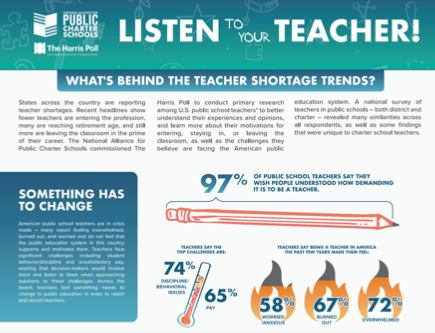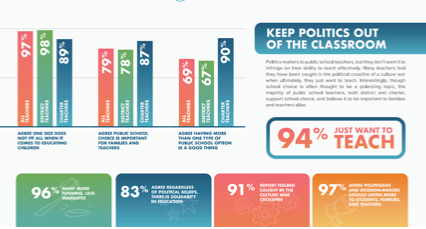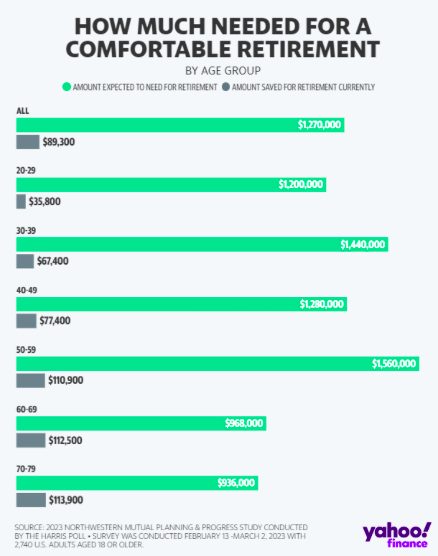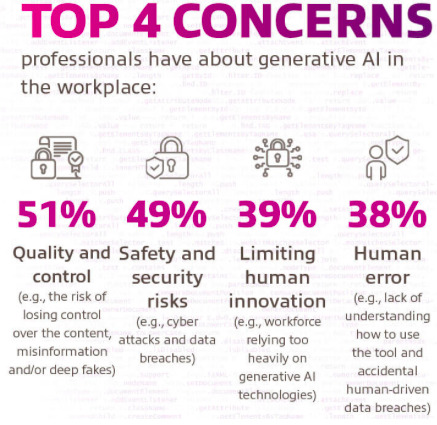Brief • 5 min Read
The latest trends in culture and society from The Harris Poll.
Last week, our CEO John Gerzema attended The Cannes Lions International Festival of Creativity, where he participated in discussions around sports diplomacy at the Stagwell Sport Beach as well as “Can Marketing Save Capitalism” with Whalar’s Jamie Gutfreund, Jeff Goodby, and Forbes’ Seth Matlin.

Reading like an episode of The West Wing, the latest global news cycle had eyes on Russia with the Prigozhin-Wagner revolt. And our America This Week survey, fielded June 23rd to 25th among 2,006 Americans, found two-thirds (67%) are still concerned about the Russian War on Ukraine, a similar number compared to mid-January (65%).
Four new Harris Polls this week caught our interest, including our new survey of burned-out teachers who cite the culture wars as a tipping point. Also, Gen Z has ambitious retirement plans, to say the least. And speaking of ambition, there’s a new friend for business leaders…AI. Lastly, Harris Poll co-CEO Will Johnson writes on the Hollywood Writers Strike in Barron’s.
You can download the new ATW monthly summary tabs and May deck here.
Teachers Caught In The Cultural Crossfire: National Alliance for Public Charter Schools-Harris Poll
A new Harris survey for the National Alliance for Public Charter Schools found that most public school teachers agree they don’t want politics to affect their teaching ability, as reported in Education Week.
- Our survey of more than 1,200 teachers conducted from May 10th to 30th found that teaching in America over the past few years has made most of them feel overwhelmed (72%), burned out (67%), and worried/anxious (58%).
- Most teachers cited student behavior, discipline issues, and pay as top challenges teachers face. Nearly all teachers (97%) said they “wish people understood how demanding it is to be a teacher.”

NAPC-Harris Poll May 2023 survey of 1,200 public school teachers
- Nearly all public school teachers surveyed (91%) say they “feel like they have gotten caught in the crossfire of culture wars,” and (94%) answered that “they just want to teach.”

- This has caused a number (39%) of surveyed teachers to either seriously consider leaving the profession in the past or plan to do so by the end of the year.
- And other teachers aren’t surprised: The vast majority of district (97%) and charter teachers (88%) say they understand why other teachers have left the profession.
- Teachers have a clear desire: Most teachers (96%) want more funding for education but fewer mandates.
Takeaway: “We owe immense gratitude to teachers,” said Nina Rees, CEO of the National Alliance for Public Charter Schools, in response to the findings. “We must listen to what they are telling us and do more to support them.” Additionally, the survey found that the vast majority of teachers “agree that public education needs more government funding, but fewer mandates,” and a majority of those surveyed said they support public school choice.
The Forty-Year Retirement: Northwestern Mutual-Harris Poll
Our latest research with Northwestern Mutual in Yahoo! Finance underscores a striking discrepancy between Gen Z’s expectations versus the reality of their retirement, and financial advisors say those who don’t adjust their outlook or their preparations might be in for a rude awakening.
- Gen Z predicts an early retirement: Boomers+ plan to work the longest (71), while Gen Z expects to retire more than a decade earlier (60). Millennials and Gen Xers plan to work to age 63 and 65, respectively.
- As well as a long life: 3 in 10 (28%) Americans think they’ll likely live to 100, but expectations are much greater among younger adults, with (40%) of Gen Z and Millennials expecting to hit triple digits.
- Yet – Gen Z may be underestimating their retirement nest egg: Gen Z expects to need just $1.2 million to fund that 40-year retirement, the lowest nest egg estimate among the four adult generations in the survey, and just (52%) say they expect to be financially prepared for retirement:

Northwestern Mutual-Harris Poll March 2023
Takeaway: “I think there’s that cusp where they’re on the edge of adulthood, and they’re starting to make money…but I don’t think they’ve kind of been fully immersed in some of the adult minutiae of life,” says Jen Grant from Perryman Financial Advisory. Still, there’s no need to burst Gen Z’s retirement bubble fully, these experts said. If they want to retire at 60 and plan for 40 golden years to follow, they need to be realistic about achieving their retirement goals.
AI’s World of Possibilities: Insight Enterprises-Harris Poll
In collaboration with Insight Enterprises, U.S. business leaders are keen to adopt generative AI at their companies to improve their operations, but concerns around quality and security are ever-present.
- The AI future is already here: 8 in 10 (81%) companies have generative AI policies and/or strategies established or in the works.
- The top reasons professionals would adopt generative AI technologies within the next three years are to improve employee productivity (72%) and customer service (66%), as well as assist with research and development (53%) and automate software development (50%).
- However, AI excitement is not without concerns: About half of the respondents expressed concerns about the implementation of generative AI technologies at their organization, with quality and control (51%) and safety and security risks (49%) topping the list:

Takeaway: “Generative AI has opened up amazing new possibilities to build, grow, and make companies more efficient and profitable,” said Matt Jackson, Insight Global Chief Technology Officer. “The pace of exploration and adoption of this technology is unprecedented. People are sitting in meeting rooms or virtual rooms discussing how generative AI can help them achieve near-term business goals while trying to stave off being disrupted by somebody else who is a faster, more efficient adopter.”
Organized Labor is Having a Moment: Barron’s-Harris Poll
Here’s Harris Poll’s co-CEO Will Johnson’s OpEd in Barron’s on the Hollywood writer’s strike:
As the Hollywood writers’ strike nears its third month, thousands of employees in the film industry are putting pressure on studios and networks. Countless movies and TV shows have been halted in recent weeks, with more dominoes to fall.
In the process, organized labor has reminded millions of Americans that its power endures, despite the decades-long decline in private-sector union membership. Since union membership peaked at over one-third of the U.S. workforce in the mid-1950s, the private-sector share has fallen to just 6% today. Public-sector membership (33%) remains robust, but few private-sector workers are part of a labor union or are interested in joining one.
Organized labor’s critics may celebrate its long-term decline, but American public opinion paints a more nuanced picture. Most Americans still support labor unions, believing collective bargaining is a powerful, necessary tool for employees to use as leverage.
According to a new survey from The Harris Poll, two-thirds (65%) of U.S. adults agree that collective bargaining is the only way for workers to guarantee fair treatment from their employers. Only (14%) of adults oppose collective bargaining, with (74%) in agreement that groups of workers who do not belong to a labor union should still be able to employ collective bargaining tactics to their advantage.
America’s view of organized labor itself is more complicated. While most Americans recognize the necessity of collective bargaining, they don’t necessarily believe that labor unions are valuable in every market segment. Six in 10 U.S. adults (57%) agree that organized labor is only necessary for workers in specific industries – emphasis on particular.
Of course, public opinion depends on the state of the U.S. economy at a given moment. Labor unions are more likely to be perceived favorably during growth periods. In economic recessions, on the other hand, their reputation is only jeopardized. Nearly (60%) of U.S. adults agree that labor unions are less potent during financial hardship – a significant caveat in 2023.
Now, what does this all mean? America’s relationship with organized labor may be complex, but public opinion does leave employers, employees, and labor unions with instructive vital takeaways. For labor unions, the task is simple (albeit difficult to execute): Make your value-add clear and conclusive to employees. While organized labor is still perceived favorably among vast swaths of the American electorate, membership declines suggest union officials must message the workers they are targeting more strategically, ensuring that those workers understand the benefits of joining – and remaining in – a labor union. Workers need to believe that the benefits of union membership outweigh the potential costs, such as union dues or perhaps even retribution from an employer.
At the same time, employers – especially anti-union ones – need to recognize that their workforce may not share their sentiments. Like labor unions, companies traditionally resistant to union organizing must clearly and conclusively state the “why not,” while those on the labor side of the table make a case for “why.” Employees, meanwhile, need to run a cost-benefit analysis for themselves. There are benefits and costs to joining and remaining in a labor union, and both sides must be considered. Suppose organized labor is active in their industry. In that case, workers should be swayed by the facts on one side or the other, regardless of the peer pressure, harassment, and intimidation that too often manifest themselves during union organizing campaigns.
In some work environments, there is a place for organized labor. In others, there isn’t. What’s clear for employers, employees, union officials, and all Americans is that public opinion on organized labor remains situation-dependent. What flies in Los Angeles film studios may not apply to other parts of America, and vice versa. Pro- or anti-union, the state of organized labor is not black and white.
Subscribe for more Insights
Subscribe to our newsletter for the latest trends in business, politics, culture, and more.
Download the Data
This survey was conducted online within the U.S. by The Harris Poll from June 23rd to 25th among a nationally representative sample of 2,006 U.S. adults.
Download
Subscribe for more Insights
Subscribe to our newsletter for the latest trends in business, politics, culture, and more.
Download the Data
This survey was conducted online within the U.S. by The Harris Poll from June 23rd to 25th among a nationally representative sample of 2,006 U.S. adults.
DownloadRelated Content







